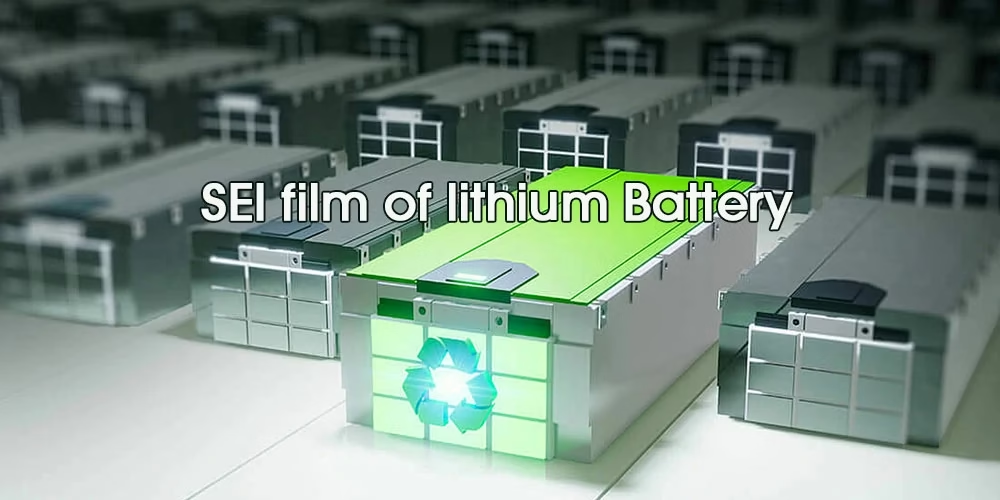
During a lithium-ion battery’s first few charge and discharge cycles, electrochemical reactions at the solid-liquid interface create a unique passivation layer on the electrode surface. We call this layer a “solid electrolyte interface” or SEI film. SEI film of lithium Battery acts as a solid electrolyte, blocking electrons while freely conducting lithium ions (Li⁺), which can move in and out through this barrier.
While a similar film forms on the positive electrode, it has a much smaller impact on performance compared to the SEI film on the negative electrode. That’s why, unless specified, when experts talk about the “SEI film,” they are referring to the one on the anode. This film results from reactions between the graphite anode and the electrolyte. Researchers have confirmed its presence using various analytical techniques, finding it to be a thin layer of 100 to 120 nm. Its composition is a mix of inorganic components like Li₂CO₃, LiF, Li₂O, and LiOH, and organic species such as ROCO₂Li, ROLi, and (ROCO₂Li)₂.
The formation of the SEI film presents a critical trade-off. On one hand, the process consumes lithium ions, which leads to an irreversible capacity loss in the first cycle and lowers the initial charge-discharge efficiency. On the other hand, this film is indispensable. Because it is stable and insoluble in organic electrolytes, it acts as a protective shield. It prevents solvent molecules from co-intercalating into the graphite, an action that would otherwise destroy the electrode’s structure. By blocking these damaging side reactions, the SEI film greatly enhances the electrode’s cycling stability and extends its overall lifespan. This dual nature is precisely why scientists continue to focus their research on understanding the SEI film’s formation, composition, and stability, and on developing ways to improve it.
I. Formation Mechanism of the SEI Film
As early as the 1970s, studies on lithium metal secondary batteries revealed the presence of a passivating layer on the lithium metal anode, which plays a crucial role in cycling behavior. With increasing understanding of this phenomenon, researchers proposed plausible mechanisms for the formation of this layer and developed several theoretical models accordingly. Among these, the SEI film model has gained widespread acceptance and application, leading to the common use of the term “SEI film” to describe such interfacial layers.
1.1 Lithium Metal Batteries
Early research primarily focused on lithium metal systems. The passivation film on the lithium anode is generally attributed to the reaction between highly reactive metallic lithium and anions in the electrolyte. The resulting products—mostly insoluble—are deposited on the lithium surface, forming a sufficiently thick, electron-blocking layer. Representative reactions include:
PC + 2e⁻ + 2Li⁺ → CH₃CH(OCO₂Li)CH₂(OCO₂Li)↓ + CH₃CH=CH₂↑
2EC + 2e⁻ + 2Li⁺ → (CH₂OCO₂Li)₂↓ + CH₂=CH₂↑
While this film cannot fully suppress lithium dendrite growth during cycling, its study has provided fundamental insights that guide the mechanistic understanding of lithium-ion batteries.
1.2 Lithium-Ion Batteries
In lithium-ion batteries, carbonaceous materials—primarily graphite—are used as anodes. The SEI formation process on these electrodes resembles that observed in lithium metal systems. Aurbach et al. proposed that EC, DMC, trace water, and HF react with Li⁺ to form compounds such as (CH₂OCO₂Li)₂, LiCH₂CH₂OCO₂Li, CH₃OCO₂Li, LiOH, Li₂CO₃, and LiF, which deposit on the anode surface to constitute the SEI film. Concurrently, gaseous byproducts such as ethylene, hydrogen, and carbon monoxide are generated. Key reactions (using EC/DMC + 1 mol/L LiPF₆ as the electrolyte system) are as follows:
2EC + 2e⁻ + 2Li⁺ → (CH₂OCO₂Li)₂↓ + CH₂=CH₂↑
EC + 2e⁻ + 2Li⁺ → LiCH₂CH₂OCO₂Li↓
DMC + e⁻ + Li⁺ → CH₃· + CH₃OCO₂Li↓ or CH₃OLi↓ + CH₃OCO·
trace H₂O + e⁻ + Li⁺ → LiOH↓ + ½H₂↑
LiOH + e⁻ + Li⁺ → Li₂O↓ + ½H₂↑
H₂O + (CH₂OCO₂Li)₂ → Li₂CO₃↓ + CO↑
2CO₂ + 2e⁻ + 2Li⁺ → Li₂CO₃↓ + CO↑
LiPF₆ + H₂O → LiF + 2HF + PF₃O
PF₆⁻ + ne⁻ + nLi⁺ → LiF↓ + LiₓPFᵧ↓
PF₃O + ne⁻ + nLi⁺ → LiF↓ + LiₓPOFᵧ↓
HF + (CH₂OCO₂Li)₂↓, Li₂CO₃↓ → LiF↓ + (CH₂COCO₂H)₂, H₂CO₃ (sol.)
The SEI film continues to grow until it achieves sufficient thickness and density to prevent solvent co-intercalation and ensure electrode cycling stability. Furthermore, the understanding of gas evolution mechanisms has contributed to the optimization of open-circuit formation processes. However, current research remains largely qualitative; advancing toward quantitative analysis and elucidating the roles of individual components represent key challenges and future research directions, with potentially significant implications for practical applications.
II. Factors Shaping the Solid Electrolyte Interphase (SEI)
The SEI film forms through reactions between the electrode and electrolyte during battery cycling. While the inherent properties of these materials largely determine the SEI’s composition, structure, and stability, external conditions like temperature, cycle count, and current density also fine-tune its final characteristics.
2.1 The Role of Anode Materials
The anode material itself is a primary architect of the SEI. Its type, composition, microstructure, and especially its surface properties, directly dictate how the film grows. Researchers have extensively studied carbon anodes—including pyrolytic carbon, carbon fibers, and various forms of graphite—and found that the material’s degree of graphitization and structural order directly translate to different SEI properties. Even on a single particle, the film can behave differently on the smooth basal plane compared to the more reactive edge sites.
For instance, studies show that pyrolytic carbon tends to build a thicker SEI, while highly oriented pyrolytic graphite (HOPG) forms a much thinner film. Other work comparing mesocarbon microbeads (MCMB) and graphite revealed that while the SEI on different carbons begins to break down at similar temperatures, the actual extent and progression of this degradation vary. These differences often stem from variations in the electrode’s surface porosity and particle size.
2.2 The Impact of Electrolyte Salts
The lithium salt in the electrolyte plays a crucial part in building the SEI. Salts typically undergo reduction more easily than the solvent, and their breakdown products become key ingredients in the film.
Common salts each have their own drawbacks: LiClO₄ is a strong oxidizer and a safety hazard, LiAsF₆ works well but is highly toxic, and LiPF₆ has poor thermal stability. This drives the ongoing search for better alternatives. The anion of the salt is particularly important, as it influences both when the SEI forms and what it’s made of. When salts containing chlorine or fluorine break down, they incorporate compounds like LiF into the film. For example, LiPF₆ can react with trace water to produce LiF, or decompose directly into LiF and PF₅. The formation of these stable, insoluble inorganic compounds like LiF helps create a robust SEI that resists degradation.
LiPF₆ (solv) + H₂O(l) → LiF(s) + 2HF(solv) + POF₃(g)
LiBF₄ (solv) + H₂O(l) → LiF(s) + 2HF(solv) + BOF(s)
Additionally, direct decomposition of inorganic salts may contribute:
LiPF₆ (solv) → LiF(s) + PF₅(s)
Thermodynamically favorable formation of inorganic lithium compounds enhances the stability of the SEI film, thereby minimizing its dissolution and degradation during electrochemical cycling. Cations also exert notable effects. For example, EIS analysis reveals that when TBAPF₆ (where TBA⁺ is tetrabutylammonium ion) is used instead of LiPF₆, the interfacial impedance increases significantly. This is attributed to the larger ionic radius of TBA⁺, which causes excessive expansion of the graphite interlayer spacing upon intercalation, leading to severe structural damage.
2.3 How Solvents Govern SEI Formation
The choice of solvent is perhaps the most critical factor in determining the quality of the SEI. Different solvents lead to films with vastly different protective qualities.
Propylene carbonate (PC) is a notorious example. In PC-based electrolytes, the resulting SEI is often patchy and incomplete, failing to fully passivate the electrode surface. This allows the electrolyte to keep decomposing, leading to a large, irreversible capacity loss. In contrast, electrolytes using ethylene carbonate (EC) as the main solvent produce a stable SEI predominantly composed of lithium ethylene dicarbonate (CH₂OCO₂Li)₂. When we add linear carbonates like diethyl carbonate (DEC) or dimethyl carbonate (DMC) to EC, they change the SEI’s makeup—yielding C₂H₅OCO₂Li or Li₂CO₃, respectively—and contribute to a more stable structure. In these common mixtures, EC is the key player that gets reduced to form the SEI skeleton, while DEC and DMC mainly serve to improve the electrolyte’s conductivity without directly contributing to the film.
We typically mix solvents to balance their properties. Cyclic carbonates (EC, PC) have high dielectric constants but are viscous, while linear esters (DMC, DEC) have low viscosity but lower polarity. Blends like EC+DMC give us the best of both worlds.
Interestingly, while PC causes problems at room temperature, research suggests that incorporating PC can actually improve a battery’s performance at high temperatures. The reasons for this are not fully understood, highlighting that the chemistry of the SEI is complex and still holds mysteries.

